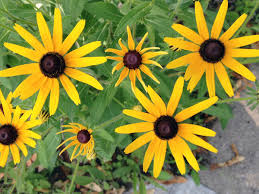Black eyed susan flower (Rudbeckia hirta) which is also known as the official flower for the Preakness and they are a member of the sunflower family. In addition to making a beautiful indoor flower arrangement, Blackeyed Susans attract butterflies, bees and other beneficial insects.
Black eyed susan flower meaning: Rudbeckia hirta, commonly called black eyed susan flower, is a North American flowering plant in the sunflower family, native to Eastern and Central North America and naturalized in the Western part of the continent as well as in China.
With Black eyed susan flower, you can also find black eyed susan vine, black eyed susan seeds, black eyed susan leaves and many more. Some people are also not aware that there is something like black eyed susan drink.
Rudbeckia hirta is an upright annual (sometimes biennial or perennial) growing 30–100 cm (12–39 in) tall by 30–45 cm (12–18 in) wide. It has alternate, mostly basal leaves 10–18 cm long, covered by coarse hair, with stout branching stems and daisy-like, composite flower heads appearing in late summer and early autumn.
In the species, the flowers are up to 10 cm (4 in) in diameter, with yellow ray florets circling conspicuous brown or black, dome-shaped cone of many small disc florets. However, extensive breeding has produced a range of sizes and colours, including oranges, reds and browns.
They require a full sun as their sun requirement and a well-drained soil. Their Zones is about: 3 – 9 with a Height of about 1 – 3 feet tall
It Blooms in: Late Summer – Mid‑Fall and is good for cut flowers
Meanwhile according to a research article recently published by By Becca Badgett, the blackeyed Susan flower (Rudbeckia hirta) is a versatile, heat and drought tolerant specimen that should be included in many landscapes. Black eyed Susan plants grow all summer long, providing perky color and velvety foliage, requiring little black-eyed Susan care from the gardener.
Black Eyed Susan Flower Care

As with many wildflowers, growing black eyed susans is simple and rewarding when blooms brighten the garden, natural area or meadow. A member of the daisy family, black eyed susan flowers go by other names, such as Gloriosa daisy or brown eyed Susan.
Black eyed Susan plants are drought resistant, self-seeding and grow in a variety of soils. Growing black eyed Susans prefer a neutral soil pH and a full sun to light shade location.
Black eyed susan flower care will often include deadheading the spent blooms of the flower. Deadheading encourages more blooms and a sturdier, more compact plant.
It also can stop or slow the spread of the black-eyed Susan flower, as seeds are contained in the blooms. Seeds may be allowed to dry on the stem for reseeding or collected and dried in other ways for replanting in other areas.
Read Also: BellFlowers – All You Need to Know About
Seeds of this flower do not necessarily grow to the same height as the parent from which they were collected. The blackeyed Susan flower attracts butterflies, bees and other pollinators to the garden. Deer, rabbits and other wildlife may be drawn to black eyed Susan plants, which they consume or use for shelter.
When planted in the garden, plant the blackeyed Susan flower near lavender, rosemary or other repellant plants to keep wildlife at bay. Remember to use some of the flowers indoors as cut flowers, where they will last a week or longer.
Black Eyed Susan Varieties

Black eyed susan plants may be annual, biennial or short-lived perennials. Heights of various Rudbeckia reach from a few inches to a few feet.
Dwarf varieties are available. Whatever the landscape situation, most areas can benefit from the yellow petaled blooms with brown centers, which begin in late spring and last throughout the summer.
- ‘Becky Mixed’, which offers a variety of colors for your garden, such as lemon-yellow, golden-yellow, dark red, and reddish-brown.
- ‘Sonora’, which has bright yellow flowers.
- ‘Toto’, which is a dwarf type and ideal for containers.
Planting
- Plant black-eyed Susans when the soil temperature has reached 70°F for best seed germination. In many parts of North America, the planting period is March to May. The flower will flower June to September. Germination takes 7 to 30 days.
- Plant seeds in moist, well-drained soil.
- These hearty flowers really enjoy the Sun. They prefer full sun, though they’ll grow in partial sun.
- Sow by seed in loosely covered soil.
- It’s best if soil is fertile (not poor) though they can tolerate tough conditions.
- Black-eyed Susans generally grow between 1 and 3 feet tall (though they can grow taller) and can spread between 12 to 18 inches, so plant seeds closer to prevent lots of spreading or plant further apart to make a nice border.
Care
- Check your plants regularly to see if they need watering. Make sure they don’t dry out.
- Divide perennial types every 3 to 4 years to ensure healthy plants and to prevent excessive spreading.
- Be sure to remove faded/dead flowers to prolong blooming.
- You can cut back black-eyed Susans after they flower and a second, smaller bloom may occur in late fall.
Pests / Diseases
- These plants are susceptible to powdery mildew fungi, so begin an organic antifungal program if the lower leaves turn brown and twisted.
- Slugs and snails
- Aphids
- Powdery mildew
- Rust
- Smut
- Leaf spots
- Luckily, black-eyed Susans are deer-resistant plants.
Harvest / Storage
After the first season, black-eyed Susans can reseed themselves!
Read Also: Complete List of Popular Common Foods and their Fiber Contents
Read Also: The Effect of Heat Stress on Animal Productivity
Read Also: 7 Amazing Health Benefits of Cherries
Read Also: Complete Guide on How To Start a Successful Chin Chin Business
Read Also: Common Best Foods to Eat and Drink for Indigestion

